LAB REPORT
Science and Technology Making Headlines
May 5, 2017

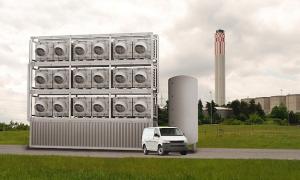
Climeworks, which will suck carbon dioxide out of the atmosphere and into a greenhouse, is set to open later this month.
Carbon dioxide sucks
The Swiss company Climeworks will soon turn on the first commercial plant to suck carbon dioxide out of the air and feed it to vegetables in a neighboring greenhouse.
It will be the first business to sell carbon dioxide drawn right out of its surroundings, using a technology called direct air capture. To date, carbon capture technologies have been restricted to areas where there are high concentrations -- like the smokestacks of coal-fired plants. But the promise of direct air capture is to grab the kind of ambient carbon emitted by cars, aircraft and trains.
“Climeworks is the first to scale up to a substantive level,” said Julio Friedmann, a former principal deputy assistant for fossil energy for the U.S. Department of Energy and senior adviser at the Lawrence Livermore National Lab. “There’s almost no way to hit those targets without using negative emissions, and in some cases, quite soon.”

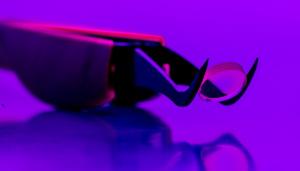
LLNL researchers have reported the synthesis of 3D printed transparent glass components using a "slurry" of silica particles extruded through a direct-ink writing process.
3D printing is smooth as glass
Lawrence Livermore National Laboratory has made a breakthrough with 3D printed transparent glass.
LLNL, in conjunction with the University of Minnesota and Oklahoma State University, has developed the innovative process using silica particles. Similarly, recent research stemming from Germany has created glass 3D printed structures using stereolithography.
However, this new approach from LLNL involves a direct writing of the material. LLNL scientists say the breakthrough could expand the design of lasers and other optical devices.

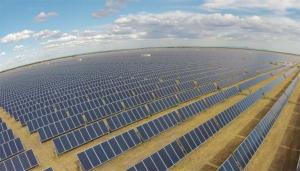
The U.S. used more renewable energy in 2016 compared to the previous year, according to the most recent energy flow charts released by Lawrence Livermore National Laboratory. Photo courtesy of National Renewable Energy Laboratory
Green is in
Americans are getting greener in their use of energy, according to the most recent energy flow charts released by Lawrence Livermore National Laboratory.
Based on the energy flow charts, Americans used more renewable energy in 2016 compared to the previous year. This means Americans now are utilizing more solar, natural gas and wind power compared to 2015.
In 2016, use of solar energy increased by 38 percent, with significant additions in electricity for commercial and residential sectors. Most of the installations of solar panels were predominantly located in the desert.

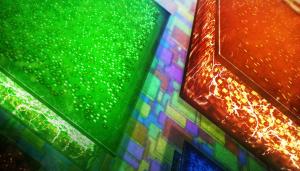
Dynamic color tunability of amorphous photonic structures in response to external electrical stimuli. Image by Ryan Chen/LLN
Coming through with flying colors
Like a chameleon changing colors to blend into the environment, Lawrence Livermore researchers have created a technique to change the color of assembled nanoparticles with an electrical stimulant.
The team used core/shell nanoparticles to improve color contrast and expand color schemes by using a combination of pigmentary color (from inherent properties) and structural color (from particle assemblies).
"We were motivated by various examples in living organisms, such as birds, insects and plants," said Jinkyu Han, lead author of a paper appearing on the cover of the journal Advanced Optics Materials. "The assemblies of core/shell nanoparticles can not only imitate interesting colors observed in living organisms, but can be applied in electronic paper displays and colored-reflective photonic displays."
Applications of electronic visual displays include electronic pricing labels in retail shops and digital signage, time tables at bus stations, electronic billboards, mobile phone displays and e-readers able to display digital versions of books and magazines.

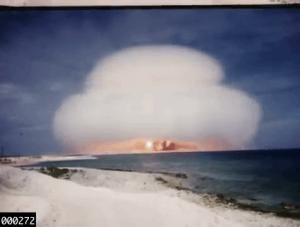
Lawrence Livermore researchers have restored 64 of the 210 films of above-ground nuclear tests from the 1950s and ‘60s.
It’s the bomb
Archival mid-century footage of above-ground nuclear tests could help physicists certify the safety and effectiveness of modern U.S. nuclear weapons.
Between 1945 and 1962, the U.S. conducted more than 200 atmospheric nuclear weapon tests and captured the detonations on film. Multiple cameras capable of recording 2,400 frames per second covered each blast, creating a highly technical record of the U.S. nuclear arsenal — and a visual deterrent against its use.
At that time physicists analyzed the roughly 10,000 classified movies to understand how the weapons worked and calculate their effects in a potential war scenario. After the Limited Test Ban Treaty was ratified in 1963, some of the data in the films became public and the recordings could be declassified — but most remained secret and stored away in government vaults.
Physicists had to design computer simulations, tested against those mid-century analyses, to “predict what would happen if a weapon went off,” says Greg Spriggs, a nuclear weapon physicist at Lawrence Livermore National Laboratory, who is leading the project to scan and declassify the films. “We’re reanalyzing the films and trying to get benchmark data: What’s the shock wave as a function of time? What would be the thermal blast? How high did the cloud go? What were the cloud’s dimensions?”





